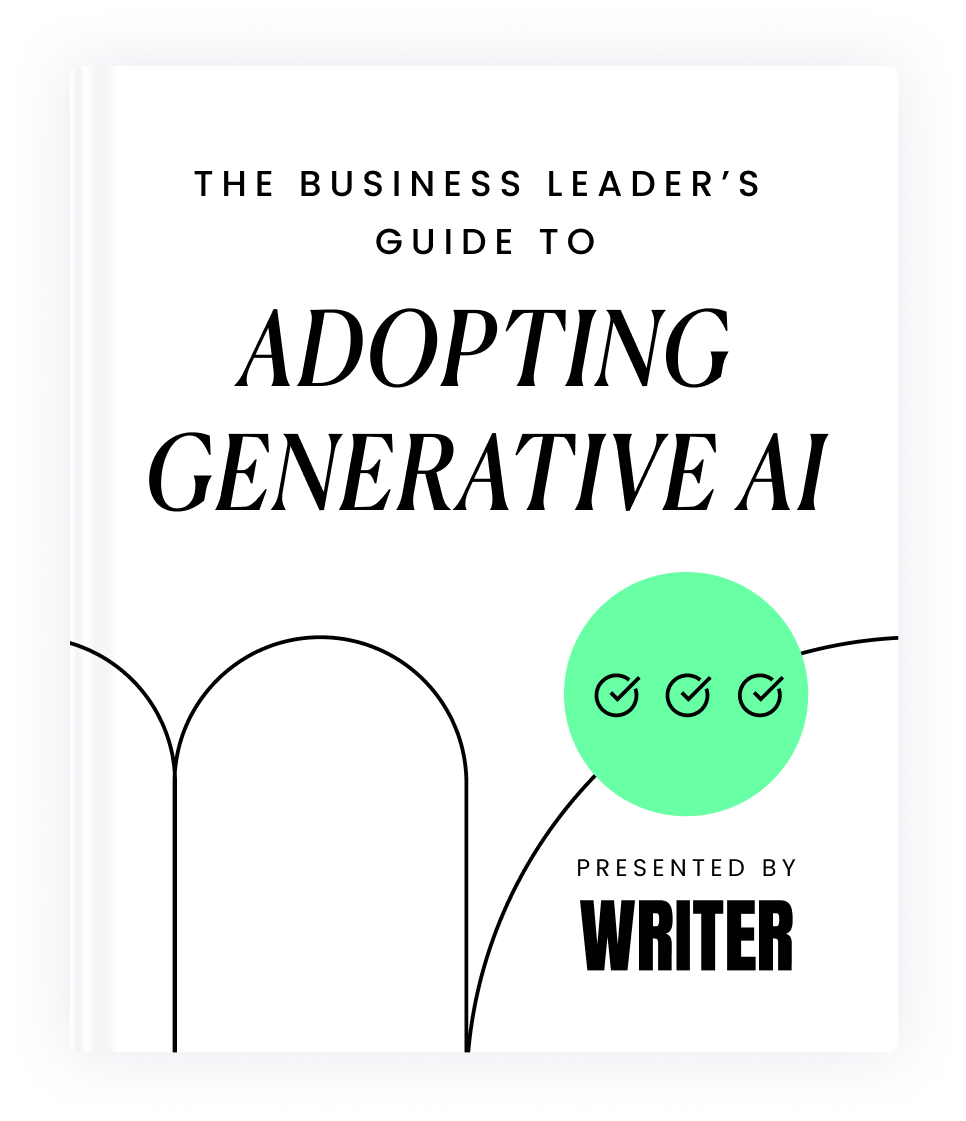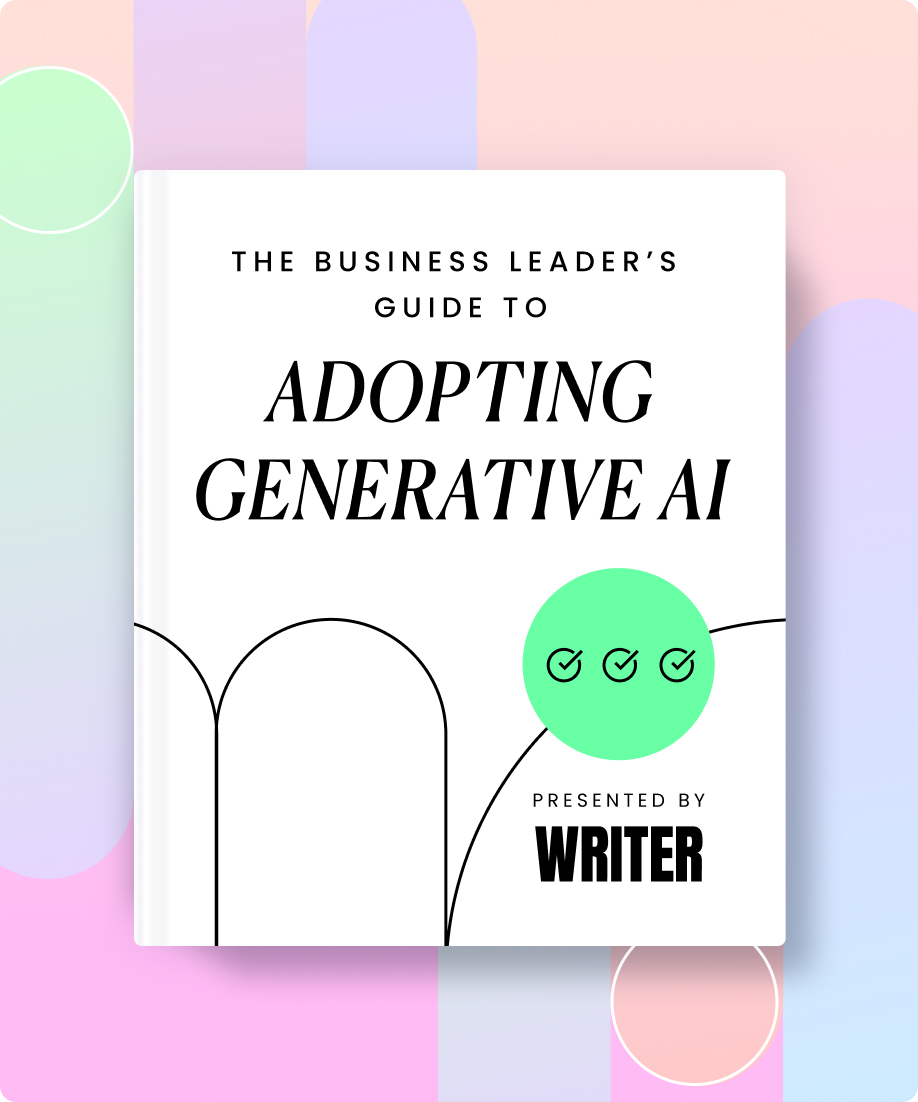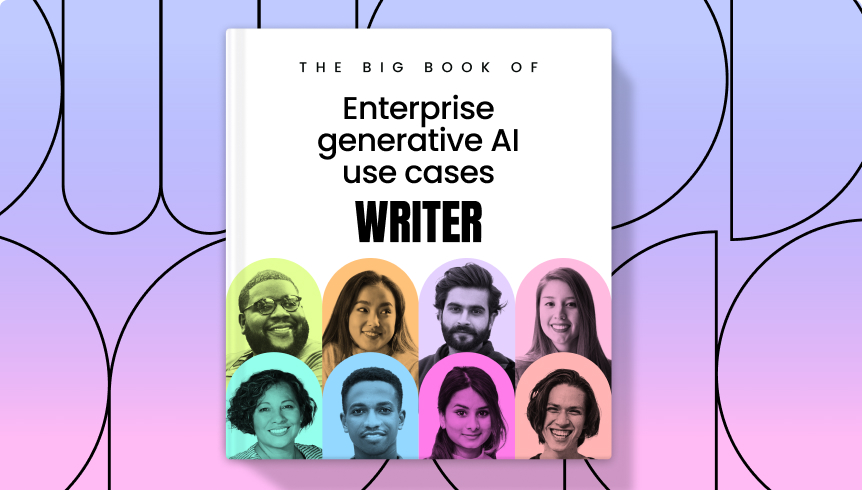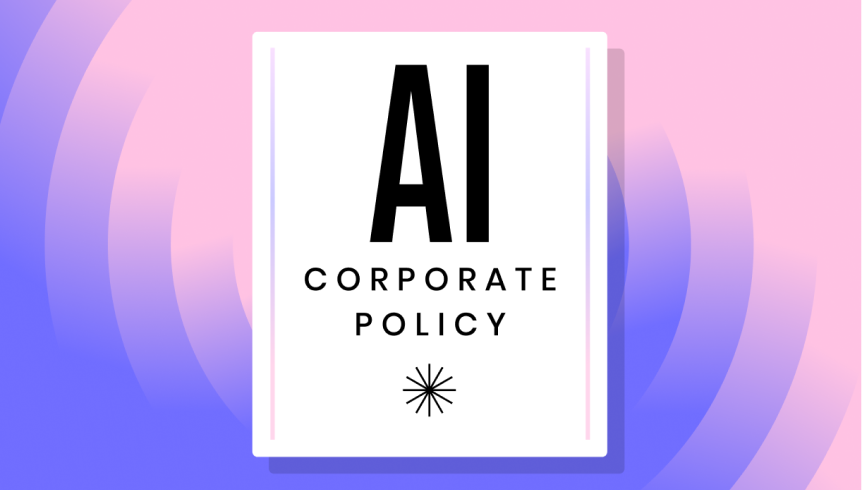
Businesses are using AI in a big way to increase efficiency and productivity. From marketing to product to support to HR, how should businesses take advantage of AI, and how should they think about preparing for the shift to generative AI? This leaders’ guide for incorporating AI into your business covers how to identify and prioritize use cases, prepare for the change management process, introduce governance workflows, and keep your brand safe while using generative AI. If you’re looking to learn more about how to bring AI into your enterprise, read on!

Download the ebook
Common use cases for AI in the enterprise
There are numerous ways that businesses are already using AI to improve productivity, output velocity, and quality. Below are just a few examples across teams and use cases:

Marketing

Support

Operations

L&D

Product

HR
The challenges of integrating AI across an enterprise
While AI can create positive transformation in a company, below are a few challenges we see enterprises have when considering adopting a generative AI solution.
Unintended bias
If AI learning models have training sets that contain biased data, they’re likely to generate biased outputs. Publishing such content can lead to unintentionally perpetuating harmful stereotypes, undermining company culture and causing damage to a company’s reputation.
Security and privacy risks
Some generative AI can learn from sensitive and proprietary data, and this data can be exposed to hackers or malicious actors.
Intellectual property issues
Generative AI can produce content that infringes on existing copyright or intellectual property.
Compliance issues
Generative AI can produce content and outputs that violate existing laws or regulations. This can lead to legal action and fines.
Unintended inaccuracies
Generative AI can produce inaccurate content, particularly when using generic language models not tuned to your brand’s specifications or company facts.
Ethical issues
Generative AI can produce content that’s unethical or offensive to certain groups of people. This can cause damage to an organization’s reputation or public image.
Data integrity and management
One of the challenges businesses face when incorporating it into their workflows is getting started. This can be a difficult task because it requires they have properly formatted, organized data from which AI algorithms can learn. Moreover, businesses need to have the right infrastructure in place to integrate AI into their workflows.
Integration
Businesses face a difficult task fitting AI seamlessly into their existing workflows. Also, they need to take steps to ensure that employees are properly trained on how to use AI tools and that they understand how AI can help them improve their work processes.
Legal “grey areas”
This is a concern for many businesses because there are currently no regulations governing the use of AI in business. As such, businesses need to be aware of the risks associated with using AI and take steps to mitigate these risks.
Using an enterprise partner such as Writer that has the experience, expertise and technology can mitigate the above issues and vastly decrease the time to implement and integrate AI across your core business workflows in a meaningful way.

Find out more about the risks associated with AI and how to avoid them. Read Generative AI risks and countermeasures for businesses.
Assess your existing workflows to find use case opportunities
When assessing how to incorporate AI into your business, it’s essential to analyze your current workflows. Start by surveying your content and processes, pinpointing key players and challenges, and evaluating opportunities to improve efficiency and accuracy through AI. All forms of communication, such as emails, memos, presentations, reports, website copy, blog posts, and social media posts, must be taken into account.
For example, consider your company’s workflow to create a blog post. You might have stages that include:
- Research and ideation
- Outlining
- Drafting
- Reviewing and editing
- Publishing
- Promoting
- Repurposing
At Writer, we use a green/yellow/red exercise to pinpoint bottlenecks, blocks, and gaps in the content lifecycle. This will give you an understanding of where improvements can be made with generative AI.
After getting a good overview of your content and workflows, identify the key players and challenges in each process. When considering key players, take into account their role in the organization and their level of expertise. For example, someone on the marketing team may have more knowledge of the customer journey than a sales person, and a senior team member may have a better understanding of the company’s objectives than a junior one.

Pinpoint the top use cases for generative AI in your organization.
Read How enterprise companies can map generative AI use cases for fast, safe implementation.
Planning the change management process
Once you’ve identified where to incorporate AI into your business, it’s essential to consider the change management process to ensure a successful transition. This includes reducing employee fear of change and constructing a governance structure to manage and regulate the use of AI, as well as reviewing security and privacy concerns.
To reduce fear in employees, it’s important to communicate the advantages of AI and how it’ll effect their work and increase their output, not replace it. Explain what the generative AI solution will and won’t do, and make it clear what remains essential to business success.
Change champions can help facilitate the transition by empowering employees who are enthusiastic about the new technology to help others learn and use AI tools. Introduce an “early adopters” program with stakeholders ready to use AI in their work, such as content marketers. This program should aim to gain early wins, and collect stories of value creation which can be shared across the business to create more buy-in from other teams.
- Understand the ROI or change benefit of a change initiative (ask Writer about our ROI assessment)
- Personalize the change, making a clear “what’s in it for me” message to each specific stakeholder group
- Use change readiness assessments to gain insight on employee attitudes
- Have an executive sponsor communicate the vision to stakeholders to build top-down advocacy
- Create an “early adopters” program to generate success proof points
- Use a change agent network to facilitate stakeholder engagement, with champions identified, enabled, and incentivized across each team
- Provide dedicated training to change agents, enabling them to communicate the change message
- Implement a robust change management toolkit to plan for the reaction to the change (ask Writer about our program owner’s toolkit)
- Measure Performance of Change to sustain awareness of the change initiatives
- Create governance structures
As businesses increasingly adopt AI, it’s crucial to have a governance framework in place to ensure that the technology is used ethically and responsibly. There are many different types of governance structures that businesses can choose from, and the right choice for your organization will depend on your specific needs and goals. The process of creating a governance framework should involve all stakeholders, including employees, management, and external experts.
How you can start to prepare
- Establish a content governance team
Create a team of stakeholders from various departments, such as marketing, legal, and IT, to ensure that generative AI is used responsibly and safely. - Set guidelines
Develop clear guidelines for how generative AI will be used, including when it should and shouldn’t be used, as well as what types of content will be created and how it’ll be distributed. - Define roles and responsibilities
Establish who’s responsible for overseeing and managing generative AI and what roles each stakeholder will play. - Monitor performance
Implement a process for regularly monitoring generative AI performance, including tracking metrics such as accuracy and speed of content generated. - Adjust and adapt
Allow for flexibility in the process, as generative AI is constantly evolving. Regularly seek feedback from your teams and adjust the governance process as needed.
Keeping your brand safe when using generative AI
- Verify all generated content is unique and accurate before using it in any marketing or promotional materials. Use Writer claim detection to validate any potential facts or claims being made. Overlay human checks on all content before publishing.
- Maintain content approval workflows throughout your content creation lifecycle.
- Make sure all generated content adheres to your company’s brand, legal, and ethical standards. Make sure Writer is set up with your brand style guidelines so your content contains approved language.
- Monitor generated content regularly to make sure it isn’t offensive or discriminatory.
- Keep track of all generated content to prevent duplication or plagiarism.
- Employ content moderation protocols to make sure generated content is suitable for your target audience.
- Make sure generated content is optimized for search engine visibility.
- Use analytics to measure the performance of generated content and make necessary adjustments.

Learn more about protecting your brand and reputation in the new technology landscape.
Read Brand safety and AI.
Review security and privacy concerns
Data security and privacy concerns should be at the forefront of your mind when adopting emerging technology – and that’s especially the case for generative AI. As more businesses adopt AI technology, there’s a greater risk of your data, and that of your customers, being fodder for the language models you’re using. It’s important you know if, and how, your data is being used in the language model for training purposes.
Your CIO office or IT team is likely to have questions before enabling an AI technology for use. You can prepare for these conversations by asking your vendor:
- How, if at all, do you use customer data in your own training models?
- Does your company have an AI safety policy?
- Does your company follow all relevant intellectual property rights in AI development and usage?
- Are methods in place to detect potential biases in AI systems?
- Do you regularly monitor AI safety for safety issues and performance degradation?
- Are audit trails implemented to track AI systems’ decisions, actions and changes?
- How is my data protected against unauthorized access?
- How is my data encrypted?
- How is my data stored and backed up?
- What measures are in place to ensure the security and privacy of my data?
- Is my data ever shared with third parties?
- How often are security protocols updated?
- Is data access logged and monitored?
- Are there any industry compliance standards that the system must meet?
As you lead the way for your company to enter the age of AI, carefully consider how generative AI technology can benefit your business and the implications of using it. It’s essential that you ensure the technology is secure, reliable, and provides adequate training and support. Taking the time to do your research and understand the technology will enable you to make informed decisions and reap the rewards of using generative AI.



